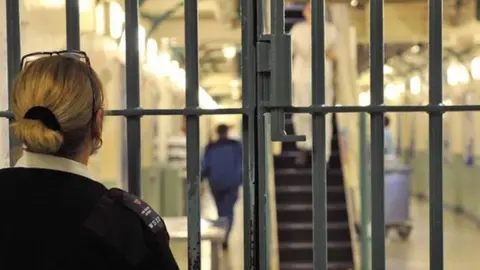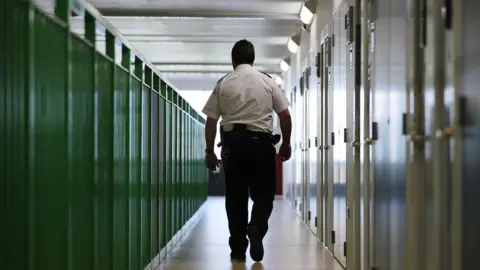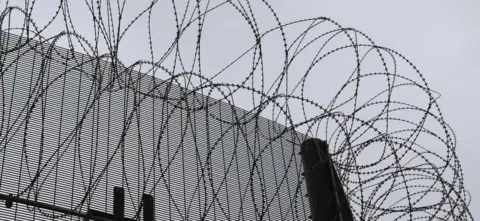How many transgender inmates are there?
 BBC
BBCClaim: The campaign group Fair Play for Women claimed 41% of transgender women in prison are convicted sex offenders.
Reality Check verdict: A government survey has counted 125 transgender prisoners in England and Wales, but the Ministry of Justice says these figures are not yet a reliable reflection of the true numbers. The MoJ says 60 of them have been convicted of one or more sexual offences but it didn't identify their gender. There are likely to be more trans inmates, on shorter sentences and who are less likely to be sex offenders, who don't show up in this data.

The background
The management of transgender prisoners is the subject of an often highly charged debate.
Trans people identify with a sex that is different to the one they were recorded as at birth (so someone recorded as male at birth may identify as a transgender woman).
Currently, to get that gender legally recognised, trans people must obtain a Gender Recognition Certificate (GRC).
As Reality Check has explained, that process is complex and can take more than five years.
The government has launched a consultation to make the process in England and Wales "less intrusive and bureaucratic for transgender people", but adds "we are not necessarily proposing self-declaration of gender."
In its LGBT action plan that accompanies the consultation, the government says it will "ensure that transgender prisoners are treated fairly, decently, lawfully with their rights respected."
In Scotland, a similar consultation ended in March.
Some worry that if the system is changed it could make it easier for dangerous prisoners to self-identify as transgender women and get moved to a women's prison.
But others argue that transgender prisoners are among the most vulnerable inmates and are let down by the current system, leading to a risk of suicide and self-harm.
The claim
The campaign group Fair Play for Women, believes that promoting transgender rights could be harmful for women.
Its spokeswoman Nicola Williams said "if proposed law changes could allow a group of dangerous offenders to be transferred to women's prisons, we need to know what risk that poses. We need data and facts - that needs to be assessed."
Fair Play for Women examined individual prison inspection reports and concluded that 41% of transgender women in prison are convicted sex offenders.
Its claim was reported by several news outlets.
If more than 40% of trans prisoners were sex offenders, that would be disproportionately high.
According to the most recent data, 19% of all prisoners are serving time for a sexual offence.
Some have taken issue with the way the group reached its conclusion so - to get a clearer picture - we went in search of the official figures.
How many transgender prisoners?
It's difficult to know exactly how many transgender prisoners there are. We asked the agencies responsible across the UK.
In April 2017, 17 of Scotland's 7,436 prisoners were transgender, according to the Scottish Prison Service.
Northern Ireland's prison service chose not to tell us whether it counts trans prisoners, but according to Parliamentary research, it is not aware of any.
In England and Wales, the Ministry of Justice (MoJ) now conducts an annual count of prisoners.
Between March and April 2017, it counted 125 transgender inmates in England and Wales, in a prison population of 85,513. It counted 70 over the same period in 2016.
These are the best available figures, but they're far from perfect.
The MoJ points out the numbers may change as prisoners constantly enter and leave the system.
It says the figures "are not yet a reliable reflection of the numbers and location of trans prisoners in the prison estate".
The MoJ can't count inmates who have not told prison staff they are transgender.
Nor does it count prisoners who have already been given a Gender Recognition Certificate (GRC).
About 250-350 GRCs are issued each year across the UK - 4,910 since 2005.
The survey only counts prisoners who have already had a case conference - a meeting of senior managers and other officials - to decide how to manage the trans person within the prison estate.
These are likely to be prisoners serving longer sentences.
The Ministry of Justice told us "prisoners on longer sentences are more likely to be managed as a transgender prisoner than those on shorter sentences".
That's because there's little point having a case conference if the inmate won't be in prison long enough to benefit from it.
 Getty Images
Getty ImagesPrisoners' convictions
We submitted Freedom of Information requests to the Ministry of Justice.
It said that 60 of the 125 transgender inmates it counted in England and Wales were serving time for a sexual offence.
This is roughly half - but it's not the full picture.
Remember - those 125 transgender inmates only include people who have had a prison case conference. It won't include transgender people who haven't identified themselves to the prison service or who already have a gender recognition certificate.
Of the 60 serving time for sexual offences:
- 27 were convicted of rape (plus a further five of attempted rape)
- 13 were convicted of possessing, distributing or making indecent images of children
- 13 were convicted of sexual assault or attempted sexual assault
- Nine were convicted of causing or inciting a child under 16 to engage in sexual activity
- Seven were convicted of sexual activity with a child
- Seven were convicted of indecent assault or gross indecency
Those numbers add up to more than 60 because some prisoners are serving time for more than one offence.
We don't know the gender of the victims or perpetrators in these cases.
The Scottish Prison Service says the 17 trans prisoners it counted were serving time for a range of crimes, including some sexual offences. But it wouldn't tell us precisely how many had been convicted of a sexual offence.
Longer sentences
The 125 transgender prisoners counted in the survey are more likely to be serving longer sentences.
That's because prisoners serving shorter sentences are less likely to have a case conference - so are less likely to be counted.
The MoJ explained that prisoners serving long sentences are more likely to be serving time for sexual offences than those on shorter sentences.
Trans prisoners on shorter sentences - who won't be in the survey - are less likely to be sex offenders.
That means that it's unlikely that as many as half of all transgender prisoners have been convicted of a sexual offence - once you take into account those trans prisoners who weren't surveyed.
Transgender journalist and campaigner Jane Fae warns against reading too much into the available figures.
"The real danger is that the public are likely to misinterpret them in a way that will create unwarranted hostility toward the minority under the microscope. The fall-out in terms of violence and abuse will, in some cases, be significant."
Managing offenders
Earlier in the year, the Daily Mail wrote that trans prisoners "can already choose whether they serve time in a male or female jail".
Can they?
 Dan Kitwood/Getty Images
Dan Kitwood/Getty ImagesThat depends. If a trans woman already has a GRC, then the National Offender Management Service says she should be housed in a women's prison.
There is provision for any female prisoner - trans or not - to be housed in a men's prison if she's deemed especially dangerous.
It's more complex if she doesn't have a GRC.
In England and Wales, she can only be located in a women's prison if she's had a case conference.
Case conferences are told to watch out for evidence that the offender's decision to transition is related to their sentence length or a way of gaining access to future victims.
The guidelines for managing transgender offenders were rewritten in 2016 after the government commissioned a review.
The report stated: "Any assessment of a transgender offender's risk of reoffending should be based on valid, evidenced factors that relate to that individual, as for any other offender. We have seen no evidence that being transgender is in itself linked to risk. Risk assessments must be free from assumptions or stereotyping."
The Scottish Prison Service also told us transgender women would not necessarily be moved to a women's prison, if that was judged to be a risk to others.
In Northern Ireland, the prison service said it would make decisions on a case-by-case basis.

James Morton is the manager of the Scottish Trans Alliance, which assists trans people in various situations - including behind bars. He says: "The prison service isn't daft. They scrutinise each case carefully.
"Before any eventual move, there is very careful risk assessment, full exploration of the person's history and current circumstances and painstaking preparation."
We don't know how often transgender prisoners ask to move prisons, or how often those requests are agreed to.
The Ministry of Justice said it was unable to collate those figures for us.



